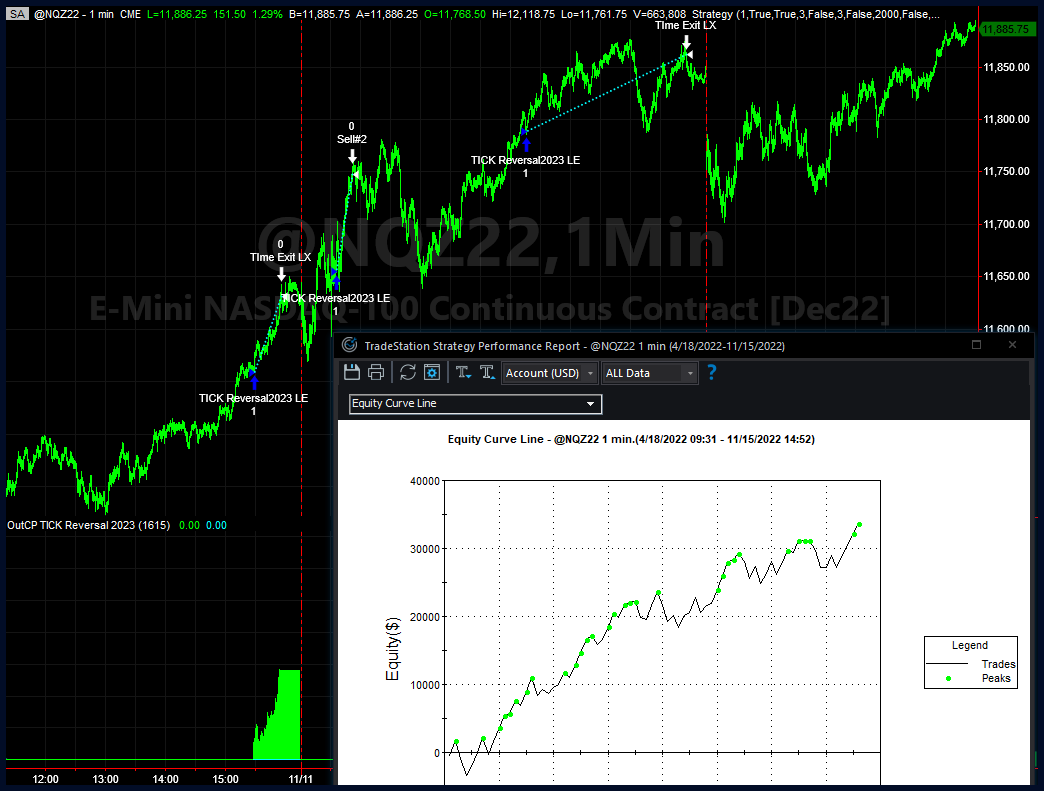TICK Reversal E-mini Nasdaq

TICK Reversal E-mini Nasdaq is a trading system that was developed in early 2022 and is based on a pattern that has become more frequent in the stock indexes since the pandemic in 2020.
It takes advantage of short term countertrend and mean reversion moves in the market and can trade throughout the day and can trade the E-mini and Micro Nasdaq, S&P, and Russell futures. There is a low frequency version released at the end of 2022, Tick Reversal 2023 that is also included in this subscription.
The subscription is a closed code annual subscription and is available in the Tradestation and Multicharts platforms.
TICK Reversal is typically included in one of our portfolios.
The subscription is a closed code annual subscription and is available in the Tradestation and Multicharts platforms.
TICK Reversal 2022 E-mini Nasdaq
Hypothetical Tradestation Performance Summary
$25 Round Turn Slippage and Commission
01/01/2016 – 11/16/2022

TICK Reversal 2023 E-mini Nasdaq
Hypothetical Tradestation Performance Summary
$25 Round Turn Slippage and Commission
01/01/2016 – 11/16/2022

Trading Nasdaq Futures Strategies on the E-mini S&P
As we prepare for 2023, we continue to notice changes in the market at higher index levels with greater short term mean reversion patterns in both the S&P and Nasdaq futures along with stocks and stock index futures in general.
We backtested both versions of Tick Reversal on the E-mini S&P and found profitable results since March 2020.
The Average Trade Profit for Tick Reversal on the E-mini S&P over the last two years is a highlight in this setup since finding a liquid futures market with high average trade profit for day trade strategies is both challenging and rare.
TICK Reversal 2022 trades more frequently than TICK Reversal 2023. We tested this on the E-mini S&P using the same exact inputs that we used on the E-mini Nasdaq and included slippage and commission.
cntrcts – number of shares/contracts to trade
DontTradeIfHoliday – set to True to not trade on holidays
UseMaxDailyEntries – set to True to limit the number of daily entries.
MaxDailyEntries – 3 is the default. Not in effect unless UseMaxDailyEntries is set to True.
UseMaxDailyLosses – set to True to limit the number of losing trades on a closed bar basis. False by default.
MaxDailyLosses – the number of losing trades allowed per day if UseMaxDailyLosses is True.
DailyLossLimit – set to False by default.
DailyLossLimitAmt – the amount of Daily Loss if DailyLossLimit is True.
WeeklyLossLimit – set to False by default.
WeeklyLossLimitAmt – the amount of Weekly Loss if WeeklyLossLimit is True.
MonthlyLossLimit – set to False by default.
MonthlyLossLimitAmt – the amount of Daily Loss if MonthlyLossLimit is True.
LongStartTime – the time of day that long trades can start signaling.
LongFinishTime – the time of day that long trades stop signaling.
ShortStartTime – the time of day that short trades can start signaling.
ShortFinishTime – the time of day that short trades stop signaling.
LongExTime – the time of day that long trades exit.
ShortExTime – the time of day that short trades exit.
ExOnClose – set to True to backtest to make sure all trades exit on close.
StpLsFirstBar – set to True for a first bar Stop Loss.
StpLsFirstBarAmt – the size of the stop loss on the first bar.
StpLsLong – set to true to make sure the stop loss for long trades are on.
StpLsLongAmt – size of stop loss if StpLsLong is set to True.
StpLsShort – set to true to make sure the stop loss for short trades are on.
StpLsShortAmt – size of stop loss if StpLsShort is set to True.
PrfTgFirstBar – set to True for a first bar profit target.
PrfTgFirstBarAmt – size of profit target on first bar.
PrfTgLong – set to true to turn on the profit target for longs.
PrfTgLongAmt – size of profit target if PrfTgLong is set to True.
PrfTgShort – set to true to turn on the profit target for shorts.
PrfTgShortAmt – size of profit target if PrfTgShort is set to True.
RFStpLsLong – set to True to turn on Range Filter long stop loss
RFStpLsLongMult – the multiplier for the RangeFilter long stop loss
RFStpLsLongMax – the maximum dollar amount for RangeFilter long stop loss
RFStpLsShort – set to True to turn on Range Filter short stop loss
RFStpLsShortMult – the multipler for the RangeFilter short stop loss
RFStpLsShortMax – the maximum dollar amount for RangeFilter short stop loss
RFPrfTgLong – set to True to turn on Range Filter long profit target.
RFPrfTgLongMult – the multiplier for the RangeFilter long profit target.
RFPrfTgLongMax – the maximum dollar amount for RangeFilter long profit target.
RFPrfTgShort – set to True to turn on Range Filter short profit target.
RFPrfTgShortMult – the multiplier for the Range Filter short profit target.
RFPrfTgShortMax – the maximum dollar amount for RangeFilter long profit target.
StpLsLongPct – set to True to turn on Stop Loss long percentage.
StpLsLongPctAmt – the percentage size of stop loss if StpLsLongPct is True.
StpLsShortPct – set to True to turn on Stop Loss short percentage.
StpLsShortPctAmt – the percentage size of stop loss if StpLsShortPct is True.
PrfTgLongPct – set to True to turn on Profit Target long percentage.
PrfTgLongPctAmt – the percentage size of profit target if PrfTgLongPct is True.
PrfTgShortPct – set to True to turn on Profit Target short percentage.
PrfTgShortPctAmt – the percentage size of profit target if PrfTgShortPct is True.
The time based inputs are based on EST. These inputs will need to be adjusted for the timezone of your computer based on its difference from EST. For example, if your computer is on CST, then LongStartTime should be 845 instead of 945 since CST is one hour earlier than EST.
The stop loss and profit targets are based on a per contract basis. If the cntrcts increases, the dollar amounts for stop loss or profit target do not need to also increase since the stop loss is calculated on a per contract basis.

